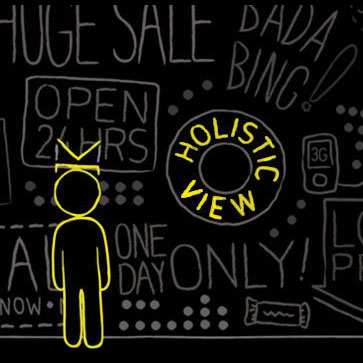Digital Advertising Master Glossary

Advertising remains for many enterprises one of the key drivers of website visits (and awareness of course) on the 'Net today. Digital advertising has evolved (and dramatically) over the past few years however and there's an immense amount to learn and consider when running a modern digital ad campaign. To set you on a course for success, Website Magazine's feature article this week provides a (hopefully) comprehensive glossary of terms that every 'Net advertising professional should be familiar with. While we certainly hope we've covered it all, if we missed one (or more) then please do share with other Website Magazine readers by sharing a comment (or two).
Ad Call: An ad exchange related term, an Ad Call is when a user's browser asks an ad server to send an ad. The typically includes information like browser cookies and ad tag information such as publisher ID, size, location etc.
Ad Exchange: One of the most commonly misunderstood terms in the digital advertising landscape, an ad exchange is a platform through which advertisers, publishers and ad networks buy and sell ads. Exchanges enable participating members to use a single, unified language to exchange data, set prices and serve ads. Also see ROE (run of exchange).
Ad Network: A platform that acts as a broker between advertisers and publishers (unlike ad exchanges which include ad networks).
Ad Server: A system responsible for actually serving the ad creative (banners, etc.) to publisher websites. Ad servers track clicks and other data. Networks, exchanges and large publishers typically have their own ad servers.
Ad Tag: Typically a snippet of Javascript code which contacts an ad server to request an ad of a particular dimension or type, and place whatever creative is returned. Behavioral Data: Information on the types of sites a user visits, the search terms they use, etc. Behavioral data is always specific to an individual visitor.
Bidding Strategy: The method used to calculate or determine the optimal bid in an ad auction. Possible options include flat CPM bidding or bidding a variable price based on history (past click through or conversion rates).
Click-through Rate: One of the most important terms for digital advertisers, click-through rate or CTR is the number of clicks received divided by the total number of impressions served for a particular creative asset or campaign.
Campaign: A term outlining a specific advertising effort, which defines specific criteria such as a start and end date, daily or overall budgets, frequency restrictions, and targeting based on user or inventory data.
Click URL: The website URL where a visitor is sent when the ad is clicked. Click-tracking URLs are often dynamically generated by an ad server before sending the visitor to the actual destination or landing URL.
CPA - Cost per action/acquisition: A payment model in which advertisers pay for specific action taken by the user, such as a sale or registration, completed as a result of a visitor clicking on their advertisement. This model is most common in affiliate marketing.
CPC - Cost per click: A payment model in which advertisers pay each time a user clicks on an advertisement. Also known as pay-per-click, this model is most commonly associated with Adwords-style advertising offerings.
CPL - Cost per lead: A payment model in which advertisers pay for every lead or customer inquiry that resulted from a visitor who clicked on a their advertisement.
CPM - Cost per thousand: A payment model in which advertisers pay for every 1000 impressions of their advertisement served. This is the standard basic pricing model for traditional online display advertising.
Demand Side Platform - DSP: A company that allows its advertising clients to buy digital media on several different selling systems or exchanges through one interface simultaneously. DSPs offer real time bidding, broader access to inventory and more robust targeting traditionally.
Display Advertising: Frequently referred to as banners, display ads are typically graphical images used by advertisers. Display ads come in standardized ad sizes, these visual banners can include text, logos, pictures, and are increasingly of a rich media nature.
Dwell Time: A measure of online ad campaign performance that accounts for the amount of time a user spends actively engaging with an ad without actually clicking on it. E.g. playing video, expanding the ad, or mousing over the ad to see some effect.
Dynamic Pricing: The purchase price for an ad impression is determined via a real-time auction rather than a predetermined rate. The term relates primarily to ad exchanges.
Engagement Mapping: Engagement mapping is a means of assessing the contribution of different media touchpoints, including advertising, to an eventual conversion. This enables advertisers to award credit for a conversion or lead to the activity that takes place before a consumer's last click (related to attribution modeling - see "first touch," "last click" and "last seen" below).
Expandable banner: Online advertising placements that expand (or take over) on the page in the response to user action such as a mouseover.
First Touch: Related to attribution modeling, the "first touch" gives credit to the first impression a user experiences. This is not as common as "Last Seen" or "Last Click" but can be used to encourage media traffickers such as affiliates to broaden reach.
Interstitial: An intentionally intrusive type of advertisement that loads between web pages without having been requested by the visitor. Also see interruptive formats.
Interruptive formats: Online advertising formats that appear on users' screens on top of web content (and sometimes before webpage appears) and range from static, one-page splash screens to full motion animated advertisements. Common interruptive formats include overlays and pop-ups.
Last Click: A type of attribution model that gives credit to the last impression that was generated and taken action upon by the user.
Last Seen: A type of attribution model that gives credit to the last impression that was seen by the user.
Lookback Window: The amount of time used for collecting data to attribute conversions. Common windows frames are one day, 14 days, 30 days, etc.
Real-Time Advertising: An auction wherein advertisers compete for that particular impression based on the individual real-time valuation of the user's worth at that time of their visit rather than in advance of the auction.
Real-Time Bidding - RTB: The actual process of bidding on inventory in real time, real-time bids are dynamically generated based on the past performance of creatives, available inventory, and other parameters. Real-time bidding requires multiple exchanges making calls to each other.
Remarketing: Marketing (or advertising) to someone who has performed an action in the past (such as a visit or a purchase), who may therefore be more likely to perform the same or a similar task in the future.
ROE - Run of exchange: All the available inventory for purchase on an advertising exchange.
RON - Run of network: All the available inventory managed by an advertising network.
ROS - Run of site: All the available inventory on a certain website.
Segment: A specific group or target audience identified based on some unique criteria such as the webpages they visit, the actions they take such as making a purchase, demographic data (such as gender) or geographic data (such as location).
Semantic Targeting: A method of advertising delivery based on the content displayed to users by the publisher. Related in part to contextual targeting.
Supply Side Platform - SSP: The counterpoint to a Demand Side Platform, an SSP enables publishers to access advertising inventory from a variety of networks, exchanges, and platforms through one interface.
Session Frequency: How many ads a user has seen per session. Advertisers can request that networks, exchanges and publishers cap (limit) the number of impressions served to an individual users in the course of one session.
Tag: A snippet of code, provided by an ad server, exchange or inventory) that tells the users' browser to request some content from an ad server for inclusion on a webpage by a publisher.
Timestamp: A sequence of characters which identify the date and time that something occurred. In the case of digital advertising, timestamps are used to confirm activity such as ad clicks and impressions.
URL Tagging: The process of embedding unique identifiers into URLs . These identifiers are recognized by Web servers on subsequent browser requests and is useful as they allow advertisers to accurately calculate the number of visits from a particular source or creative asset.
Web Beacon: Big data requires an immense amount of tracking - which is why Web beacon should be in your advertising lexicon. A Web beacon is essentially a line of code used by a website or ad server to track a users's activity (e.g. registration, conversion). Beacons are invisible to users (they are typically colorless 1x1 pixels. Web beacons are also referred to as "tracker GIFs".
Yield: Few advertisers understand yield but it's a very meaningful metric to understand creative performance. The Yield is the percentage of clicks versus impressions on an ad within a specific page (it's also called the ad click rate).










